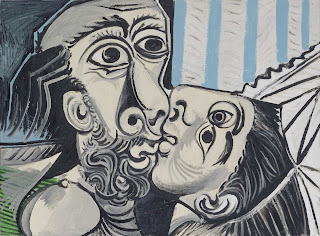 |
| Jacqueline with crossed hands (1954), oil on canvas, 116x88.5cm |
Walking through Picasso: Masterpieces from the Musée National Picasso, Paris, now on at the Art Gallery of New South Wales, feels very much like reading Picasso’s diary. It’s chronological, it’s representative, it’s rare. And it’s fabulous.
About 150 paintings, drawing and sculptures showcase seven decades of Picasso’s art, arranged to cover his life from 1895 through to 1972 and representing works from the Blue, Rose, expressionist, cubist, neoclassical and surrealist periods. They are set in nine rooms, making it easy to trace the changes and influences that played on the young artist culminating in the revolutionary figure we admire today.
One of the most influential artists of the 20th century, Picasso’s work is both mesmerising and complex. What struck me the most were the works built on classical realism. Classical influences appear to offer a solid grounding for Picasso when all else around him is caught up in the throes of war. In his hand, Olga becomes a marble statue (Portrait of Olga in an armchair, 1918). Her solidness posited against a seemingly unfinished background is a reflection of where meaning may lie, when war is eating away at everyday ‘realities.’
My absolute favourite is Two women running on the beach (The race) (1922), with its emotive feeling of abandon and freedom. The vivid blues and the flowing hair are anchored in the elongated brown limbs, contorted yet supple. There’s a sense of fullness that makes you feel that this is how life must be lived – and war must be abandoned.
 |
| Two women running on the beach (The race) (1922), gouache on plywood, 32.5x41.1cm |
These women share no conventional beauty, for they have been re-arranged through contortions and fractures. The Portrait of Dora Maar (1937), for instance, is of a woman in profile, but who still manages to look directly out at the world. It’s disjointed, but full of presence; the blooming flowers bring catharsis to the confined space; red nails and the elegant pose speak of strength and determination. It was the year he condemned the rebellion of General Franco against the Spanish Republic and painted Guernica; and Maar joined him on both fronts – condemning the rebellion and documenting the work in progress.
 |
| Portrait of Dora Maar (1937), oil on canvas, 92x65cm |
Picasso’s sculptures, influenced by tribal art, are also a key feature of the exhibition. The bronze sculptures titled Head of a woman (Fernande) (1909), Woman doing her hair (1906) and Reclining bather (1931) are raw and emotive. They are daring in their exploration of form on bronze, such as the rolling waves of hair and the sinuous tendons on the neck on Fernande.
The last painting in the exhibition The young painter (1972), completed a year before his death, is a testament to the artist’s spirit that drove him to the end of his days. It’s playful in character, but aging in tone, and the smile brings a twinkle to the black-dot eyes.
 |
| The kiss (1969), oil on canvas, 97x130cm |
Picasso: Masterpieces from the Musée National Picasso, Paris ends on 25 March 2012.
Images supplied by the Art Gallery of NSW











No comments:
Post a Comment